
4.1
Wiring
Follow the wiring table below to connect the CR-301 sensor to a controller. The Grey wire and the Brown
wire are the power ground and internally connected. The Grey wire can be used for the 4–20 mA return.
The Blue and Yellow wires are for RS-485 connection only and only required if using Modbus protocol. The
Green earth ground wire should be connected to the controller chassis ground if it is available.
Table 2.
Wire Color
Designation
Red
24V +
Brown
24V Power ground
White
General corrosion rate, 4–20mA +
Pink
Localized corrosion rate, 4–20mA +
Gray
*
4–20mA -
Blue
RS-485 A
Yellow
RS-485 B
Green
Shield, earth ground
*
Internally connected to the power ground
The CR-301 comes with 4–20mA transmitters embedded in the sensor body. It provides outputs on two
channels of 4–20mA signals that represent general corrosion rate and localized corrosion rate respectively.
Default alloy factors and corrosion rate scales in mils per year (MPY) are pre-programmed for each metal-
lurgy in the uPyxis APP as outlined in the
Test Metal Electrode Default Settings
table. When a metallurgy is
selected from the drop-down list, the uPyxis APP will automatically assign default alloy factor and 4–20mA
scales for both general and localized corrosion. The corrosion rates scales provided by uPyxis are commonly
appropriate for the range of typical corrosion observed of the selected metallurgy, however, the user may
desire to alter the alloy factor or corrosion rate scale for any selected metallurgy in the uPyxis APP.
The user may alter the 4–20 mA output from the CR-301 to a desired corrosion rate in the unit of MPY
by setting up one of three configurable parameters. The configurable parameters include 1) alloy factor,
2) the sensor’s 4–20 mA range and 3) the controller’s 4–20 mA range. The first two reside in the CR-301
sensor itself and can be configured by using the uPyxis app.
CR-301 User Manual
| +1 (866) 203-8397
7
Summary of Contents for 51021
Page 1: ......











































